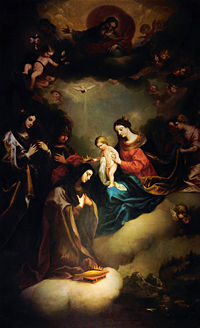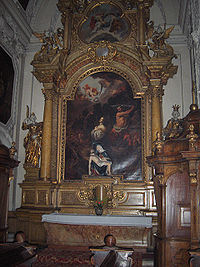
Tobias Pock
Encyclopedia
Tobias Pock (Konstanz
, 1609 - Vienna
, 12 June 1683) was an Austrian Baroque
painter from Swabia
n descent, a pioneer of sacral art.

 His father worked as a master at the Cathedral of Konstanz, when Tobias Pock was born. Tobias Pock probably was an apprentice painter in Southern Germany. He worked mainly at first in Konstanz. But, after his trip to Italy, he settled around 1640 in Vienna, where he became a leading painter. He painted portraits, history canvases and still lifes, but he is mostly recognized for his many paintings of saints in churches in Vienna, Lower Austria
His father worked as a master at the Cathedral of Konstanz, when Tobias Pock was born. Tobias Pock probably was an apprentice painter in Southern Germany. He worked mainly at first in Konstanz. But, after his trip to Italy, he settled around 1640 in Vienna, where he became a leading painter. He painted portraits, history canvases and still lifes, but he is mostly recognized for his many paintings of saints in churches in Vienna, Lower Austria
and Steiermark. His style is similar to the contemporary style of Southern Germany (München, Augsburg), but also contains influences from Flanders and Northern Italy.
He left a considerable body of work :
Konstanz
Konstanz is a university city with approximately 80,000 inhabitants located at the western end of Lake Constance in the south-west corner of Germany, bordering Switzerland. The city houses the University of Konstanz.-Location:...
, 1609 - Vienna
Vienna
Vienna is the capital and largest city of the Republic of Austria and one of the nine states of Austria. Vienna is Austria's primary city, with a population of about 1.723 million , and is by far the largest city in Austria, as well as its cultural, economic, and political centre...
, 12 June 1683) was an Austrian Baroque
Baroque
The Baroque is a period and the style that used exaggerated motion and clear, easily interpreted detail to produce drama, tension, exuberance, and grandeur in sculpture, painting, literature, dance, and music...
painter from Swabia
Swabia
Swabia is a cultural, historic and linguistic region in southwestern Germany.-Geography:Like many cultural regions of Europe, Swabia's borders are not clearly defined...
n descent, a pioneer of sacral art.


Lower Austria
Lower Austria is the northeasternmost state of the nine states in Austria. The capital of Lower Austria since 1986 is Sankt Pölten, the most recently designated capital town in Austria. The capital of Lower Austria had formerly been Vienna, even though Vienna is not officially part of Lower Austria...
and Steiermark. His style is similar to the contemporary style of Southern Germany (München, Augsburg), but also contains influences from Flanders and Northern Italy.
He left a considerable body of work :
- StephansdomStephansdomSt. Stephen's Cathedral is the mother church of the Archdiocese of Vienna and the seat of the Archbishop of Vienna, Christoph Cardinal Schönborn, OP...
, Vienna : baroque altar painting "The Stoning of St. Stephen"(1640-47) (his earliest known work). - Dominican churchDominikanerkirche (Vienna)The Church of St. Maria Rotunda, also known as Vienna's Dominican Church , is an early Baroque parish church and minor basilica in the historic center of Vienna, Austria...
, Vienna :- Altar of Saint DominicSaint DominicSaint Dominic , also known as Dominic of Osma, often called Dominic de Guzmán and Domingo Félix de Guzmán was the founder of the Friars Preachers, popularly called the Dominicans or Order of Preachers , a Catholic religious order...
: altar painting (1655), depicting the saint adoring the Trinity. - Chapel of St. Catherine of AlexandriaCatherine of AlexandriaSaint Catherine of Alexandria, also known as Saint Catherine of the Wheel and The Great Martyr Saint Catherine is, according to tradition, a Christian saint and virgin, who was martyred in the early 4th century at the hands of the pagan emperor Maxentius...
: altar painting
- Altar of Saint Dominic
- SchottenkircheSchottenstift, ViennaThe Schottenstift or Scottish Abbey is a Roman Catholic monastery founded in Vienna in 1155 when Henry II brought Irish monks to Vienna. The monks did not come directly from Ireland, but came instead from St Jakob's, the Irish monastery in Regensburg, Germany...
, Vienna : paintings for the high altar and the Apostelaltar (1651-1655) - Michaelerkirche, Vienna : high altar painting (1642)
- Maria Himmelfahrt basilica, Sankt PöltenSankt PöltenSankt Pölten is the capital city of the State of Lower Austria in northeast Austria. With inhabitants , it is Lower Austria's largest city...
: high altar painting Assumption (1658) - Church of the Teutonic OrderDeutschordenskirche (Vienna)The Church of Saint Elisabeth of Hungary , also known as Church of the Teutonic Order , is the mother church of the Teutonic Order, a German-based Roman Catholic religious order formed at the end of the 12th century...
, Vienna: high altar painting Coronation of Virgin Mary, surrounded by the Patron saints of the Teutonic Order Saint Elisabeth of ThüringenElisabeth of HungaryElizabeth of Hungary, T.O.S.F., was a princess of the Kingdom of Hungary, Countess of Thuringia, Germany and a greatly-venerated Catholic saint. Elizabeth was married at the age of 14, and widowed at 20. She then became one of the first members of the newly-founded Third Order of St. Francis,...
and Saint GeorgeSaint GeorgeSaint George was, according to tradition, a Roman soldier from Syria Palaestina and a priest in the Guard of Diocletian, who is venerated as a Christian martyr. In hagiography Saint George is one of the most venerated saints in the Catholic , Anglican, Eastern Orthodox, and the Oriental Orthodox...
(1667) - Mariazell BasilicaMariazell BasilicaThe Mariazell Basilica is a Marian basilica in Mariazell, Austria. It is the most important pilgrimage destination in Austria and one of the most visited shrines in Europe...
: high altar painting - Decoration of the altar in the Dominikuskapelle at the Imperial Crypt, ViennaImperial Crypt, ViennaThe Imperial Crypt in Vienna, Austria lies below the Capuchin Church and monastery founded in 1618 and dedicated in 1632. It is on the Neuer Markt square of the Innere Stadt, near the imperial Hofburg Palace...
- Cartesian monastery in Brno-Královo PoleKrálovo PoleKrálovo Pole indoor arena was an indoor sporting arena located in Brno, Czech Republic. The capacity of the arena was 10,200 people. It opened in 1947 and closed in 1998....
: painting (now substituted by a less valuable picture) - Svatý Kopeček (Saint Hill) near OlomoucOlomoucOlomouc is a city in Moravia, in the east of the Czech Republic. The city is located on the Morava river and is the ecclesiastical metropolis and historical capital city of Moravia. Nowadays, it is an administrative centre of the Olomouc Region and sixth largest city in the Czech Republic...
, Basilica Minor, St. Pauline, 1681, Altar of the Chapel of St. Pauline

